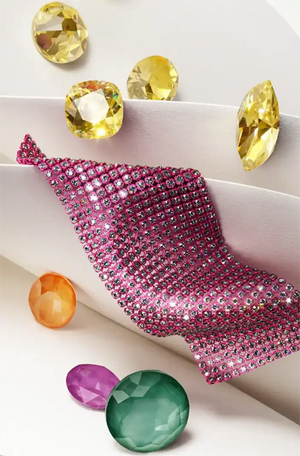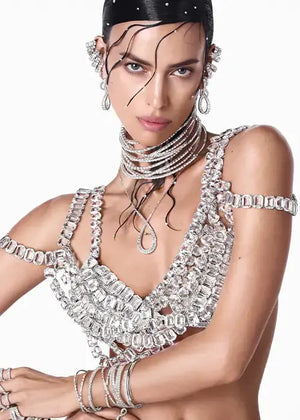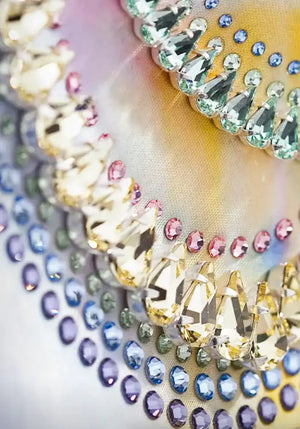
A Comprehensive Glossary: Jewellery Making Terms and Jargon
Whether you’re curious about the ins-and-outs of jewellery making or you’ve already started your business, it can take a while to familiarise yourself with all the jewellery terms and jargon used to describe various steps in the creative process. To help you out, we’ve created our own comprehensive jewellery glossary, sorted from A-Z for your convenience!
Alloy
An alloy is a mixture of two or more metals combined to create a new material with improved properties, such as increased strength or resistance to tarnish. Sterling silver is a good example of an alloy, comprising 92.5% silver and 7.5% other metals, typically copper.
Annealing
This is a heat treatment process used to make metal more workable. By heating and then slowly cooling the metal, annealing softens the material, making it easier to bend, shape, and manipulate.
Bail
A bail is a metal component that connects a pendant to a necklace or a charm to a bracelet. It often has a loop or a hole to allow a chain or cord to pass through.
Bezel
A bezel is a metal band used to secure a stone to a piece of jewellery. The bezel is shaped to the exact dimensions of the stone and is often used for rings, earrings, and pendants.
Cabochon
A gemstone that has been shaped and polished as opposed to faceted. The resulting form is usually a convex top with a flat bottom, making it ideal for setting in jewellery.
Casting
Casting is a jewellery making process where molten metal is poured into a mould to create a specific design. Once the metal cools and solidifies, it takes the shape of the mould.
Chasing
This is a metalworking technique where the surface of the metal is indented from the front, using a hammer and chisel, to create a design. Chasing is often used in conjunction with repoussé to create intricate relief work on the metal's surface.
Clasp
A clasp is a fastener used to secure a piece of jewellery when worn. There are many types of clasps, such as lobster clasps, toggle clasps, and magnetic clasps, each serving the same purpose but offering different aesthetics and functionalities.
Die Striking
This process involves a metal sheet being struck by a die, a steel tool engraved with a design. The force of the strike imprints the design onto the metal, creating detailed and intricate work.
Enamel
Enamel refers to the glassy, often colourful substance fused onto a metal surface for decorative purposes. This technique adds colour and texture to jewellery pieces.
Findings
A term used to describe the various components used in jewellery making. Findings include items such as clasps, earring backs, jump rings, and bails - sterling silver findings are very popular amongst jewellery makers for their durability and high quality.
Forging
A metalworking process where the metal is heated and then hammered into shape. This technique is often used to create a textured surface or to alter the shape of a piece of metal.
Gemstone
A gemstone is a natural mineral or organic material that has been cut and polished for use in jewellery. Gemstones come in a wide range of colours and levels of hardness, each with its unique properties and value.
Hallmark
A stamp or mark applied to a piece of metal jewellery that signifies the metal's purity. Hallmarks often indicate the type of metal (such as sterling silver or 18k gold), the maker's mark, and sometimes, the year of manufacture.
Inclusions
Inclusions refer to the internal flaws or characteristics found in gemstones, such as cracks, bubbles, or foreign material. While often viewed as imperfections, inclusions can add uniqueness to the stone and are useful in identifying natural gemstones.
Jump Ring
A jump ring is a circular piece of metal with a cut along its circumference. It's a versatile finding used in various aspects of jewellery making, such as attaching pendants to chains or connecting different components together.
Karat
A unit of measurement used to describe the purity of gold. Pure gold is 24 karat, with the number decreasing as the amount of gold in the alloy decreases. For example, 18 karat gold contains 75% gold and 25% other metals.
Lapidary
A term used to describe the practice of cutting, shaping, and polishing gemstones. A person who works in this field is known as a lapidary or lapidarist.
Lost Wax Casting
Also known as investment casting, this method involves creating a wax model of a piece, investing it in a plaster mould, melting out the wax, and then pouring molten metal into the cavity where the wax once was.
Mohs Scale
A scale used to measure the hardness of minerals, including gemstones. The scale ranges from 1 (talc) to 10 (diamond), and is useful in identifying gemstones and determining their suitability for various types of jewellery.
Pavé
From the French word for "paved", this term refers to a setting technique where small gemstones are set close together, covering a surface and giving the appearance of being paved with stones.
Pendant
A pendant is a loose-hanging piece of jewellery, generally attached by a small loop to a necklace, which may be known as a "pendant necklace". A pendant typically comes in the form of a locket, cross, charm, or a gemstone, with Swarovski pendants being an incredibly popular choice for luxury jewellery pieces.
Prong Setting
A type of gemstone setting where metal projections, or prongs, hold the stone in place. This setting allows more of the gemstone to be visible, enhancing its brilliance.
Repoussé
A metalworking technique where the design is hammered into the back of the metal, creating a raised surface. This technique is often used in conjunction with chasing to create intricate designs.
Rhodium Plating
A process where a layer of rhodium, a precious metal, is applied to the surface of another metal. This process increases the durability, lustre, and brightness of the piece.
Soldering
The process of joining two pieces of metal together using a filler metal (solder). The solder melts when heated, flows into the space between the pieces being joined, and hardens as it cools, creating a secure bond.
Tumbled Stones
Gemstones that have been polished in a machine known as a tumbler, which uses grit and water to smooth and polish the stones. The resulting stones have a polished, shiny appearance and rounded edges.
Vermeil
A type of gold finish where a thick layer of gold is plated onto sterling silver. This provides the appearance of gold, but at a fraction of the cost.
Wire Wrapping
A technique where metal wire is wrapped around itself and other components without using solder or glue. This method is used to make a variety of jewellery pieces, including rings, earrings, and pendants.







